1929 - 1945

Ernst Guenter Hansing is born in Kiel on 15th of June in 1929.
Death of his father.
Bombing of the refugee ship on which Hansing tried to escape from the Russian troops. Hansing is one of the few survivors. This traumatic experience leaves a lasting mark.
1948 - 1952

Apprenticeship as a goldsmith.
Hansing creates expressive paintings with which he wants to free himself in his traumatic war experiences.
He visits Emil Nolde and is given the advice: „Don’t let yourself be diverted from your path. Without doubt you have talent.“
Another great artist gives advice and encouragement regarding an artist’s life. Oskar Kokoschka writes: „Talent you have, but you should learn till the end. Only who can do a lot, realises that he is still missing the biggest part if he sets the right scale“.
1952 - 1953

A fellowship of the French government opens the way to the school of Fernand Léger who recommends strict principles of composition to Hansing’s expressive way of painting. He learns to observe and to draw precisely.
Hansing meets Pablo Picasso in France.
A deep friendship develops with the writer Clara Malraux, the wife of the French Minister of Cultural Affairs André Malraux. She introduces him to well-known personalities of the cultural life of France: with the sculpturer Germaine Richier and with the art dealer Daniel-Henry Kahnweiler.
The impression of the glass windows of Chartres become a key experience for his whole artistic career. The blue which shines forth from mystical depths calls forth the proverbial „Hansing-Blue“ of future works.
1955 / 1956

One of the early paintings is an „Hommage à Fernand Léger“, a portrait which catches the essence of Léger in a meticulously lined composition.
Another highlight of his early portraits is the portrait of the poet Hans Henny Jahn.
1955 / 1956
Hansing creates numerous glass windows and ceramic mural reliefs in abstract forms
Hansing develops into a multifaceted artist: he explores glass painting, sculpture, mural relief, graphic art and painting as realms of expression with equal mastery.
He meets Chagall, Dalí and Manessier.
From now on, great themes in Hansing’s oeuvre are the „cosmic eruptions“ and paintings of Christ. The cross becomes a central pictorial sign: a symbol of the core of meaning.
The establishment of an atelier at the Place St. Germain des Prés in Paris seals his love of France.
1963

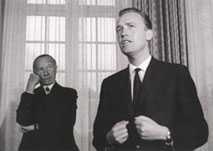
Konrad Adenauer lets the young francophile Hansing create a portrait series of himself and opens the possibility to exhibit the portraits in the Palais Schaumburg.
Adenauer calls these explorations of his facial landscape „visions – not portraits in the usual sense“.
1963 - 1996
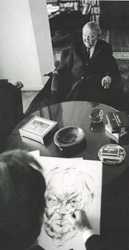
With the Adenauer-portraits Hansing, begins to become the chronicist of the „Bonn Republic“.
He draws and paints „interior paintings“ of many political personalities: among others Ludwig Erhard, Walter Scheel, Herbert Wehner, Willy Brandt, Richard von Weizsäcker, Helmut Kohl.
But one does not have to be famous to be painted by Hansing; one must fascinate the artist with a pictorial theme and has to keep his creative process awake till the last end result.
Hansing’s portraits have nothing to do with external representation but rather with his surreal exaggerated landscapes and cosmic paintings. The intent of this form of representation is to grasp human beings as part of the universe.
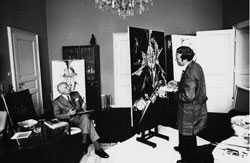
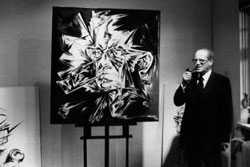
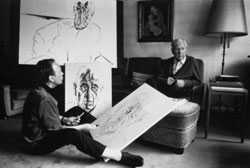
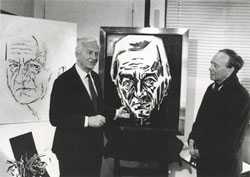
1964

One figure who arrests Hansing’s attention is the archbishop Josef Kardinal Frings. His portraits are two of the most impressive portraits of Hansing’s creative period of the 60ies.
Via Frings the gates of the Vatican in Rome are being opened to Hansing, first to Paul VI., but they remain open under the pontificate of John Paul II.
1969 / 1972
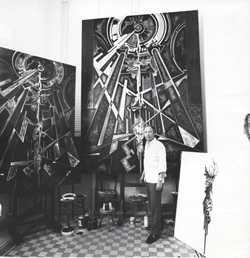
Sketches, studies and the main work „Papacy“ with the portrait of Pauls VI.
On the occasion of the first public display of the main work, the Pope recommends to the world public that one should not pass by this painting too quickly. Only in longer contemplation, one is able to gain access to its whole depth. It demanded an “act of reflection” from the beholder. Such an advice indeed holds true for the comtemplation of all of Hansing’s works.
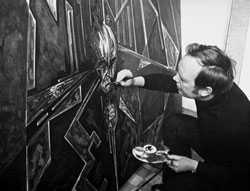

1973
Pope Paul VI. inaugurates the „Collezione d‘Arte Religiosa Moderna‘“ in the Vatican in which there are five works of Hansing.
1978

Distressing drawings of the blind Cardinal Frings are made one week before his death.
In Rome Pope Paul VI. dies and Hansing draws the dead body of the Pope.
Hansing makes sketches of John Paul II. which prepare the big painting „The Pilgram Pope“.
1987 - 1994
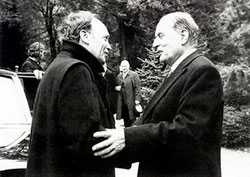
Meeting with the French president Francois Mitterrand at Adenauer’s grave at the forest cemetery of Rhöndorf.
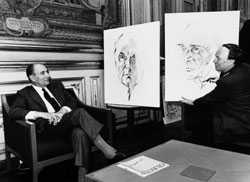
The drawings and paintings which result from the invitation to portrait sessions in the Parisian Elysée constitute one of the most important groups of Hansing’s portraits.
Mitterand honours the artist with a visit in his Parisian atelier.
On a series of envelopes, Hansing draws Marc Chagall who sits at the neighbouring table at a restaurant in St. Paul de Vence (Southern France). On the basis of these sketches he develops the series of portraits „Hommage à Chagall“.
1988

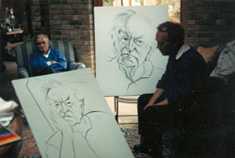
Hansing gets acquainted with the world famous director David Lean in St. Paul de Vence („Doktor Shivago“, „The Bridge on the River Kwai“, „Lawrence of Arabia“) and paints his portrait.
1989 - 1991

Years of awards:
an honorary professorship, appointment to the commander of the order of St. Gregory by Pope John Paul II., award of the Bundesverdienstkreuz 1st class.
1990
Hansing crowns his series of portraits of great artists with a painting of the violin virtuoso Anne-Sophie Mutter. In these paintings all forms become sound. „Here the whole body has become music“, she commented the main work.
1995
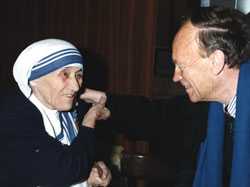
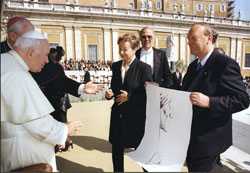
The portrait works of the artist culminate on the portraits of Mother Teresa whom the Hansing couple meet in Rome.
Hansing finds a formal language of extreme simplicity for the „hard-working Samaritian and believing visionary“. In the main portrait there is no more than one falling line which connects the face which is lifted upward to heaven with praying folded hands.
Any additional drawn element would have been less according to the artist, „for“ – says Hansing - „this woman is so unspeakably rich. She incorporates the essential, that which ultimately matters. And thus one has to be able to leave out to show more“. This has also been the artistic Credo of Ernst Guenter Hansing’s work until the present day.
1998
Portrait of Adolf Kolpings in the Catholic Social Institute of the Archdiocese of Cologne in Bad Honnef.
1999 / 2000
Drafts of a Nirosta-steel sculpture for the Landes-Entwicklungs-Gesellschaft (LEG, State Development Society) in Kiel and realisation in the Kruse craft workshop in Flensburg.
2002
Portrait of the Bishop of Essen Hubert Luthe and acquisition of the painting by the bishop’s estate.
2005

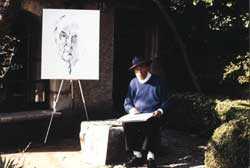
Founding of the „Circle of Friends Ernst Guenter Hansing “ for the cultivation, dissemination and exploration of the work of Ernst Guenter Hansing.
2006 - 2009
Portrait of Wolfgang Clement
Handing over to the state office Duesseldorf, Germany
Kleine Grafik Auflage: Wolfgang Clement
A number of exhibitions
2010
The book 'Ernst Guenter Hansing in selfreports' is published
2011
Ernst Guenter Hansing dies on the 31rst of January 2011 in his house in Rhoendorf/Bad Honnef on the Rhine, Germany.
He leaves an important artistic lifework.